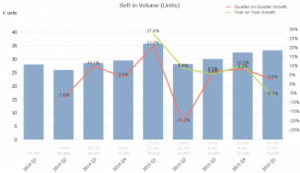
It’s been a very busy week at our company as we finalised our quarterly data for the Public Display and Desktop monitor markets and Tom was at a UK TV event, as well as writing up his report on the Berlin event that he attended last week. Meanwhile, I also attended an event run by Maverick in the UK to promote the Microsoft Surface Hub product, which has finally started to ship. Comments at the show suggest that that it will be the end of Q3 before stock will be freely available and that, at the moment, you need to have the ear of a high Microsoft executive if you want an early delivery. It seems that Microsoft has had real yield problems with the touch display on the Surface Hub, but these are solved or close to solved now.
As the front page story in Large Display Monitor shows, the growth in the European public display market is beginning to slow, especially in the most developed markets of the UK and Germany. I have to create our new forecast next week, so I have a lot of thinking to do about what happens next. Traditionally all technology goes through an “S” curve of accelerating growth (the ‘ascent’ phase) and then a maturity period, followed by an eventual decline. Typically some groups of customers or geographies drive the early growth which then diffuses to other customers and regions during the latter parts of the growth or maturity phases.
The public display market looks a little as though these phases seem to have got “out of phase”. The most developed markets, Germany and the UK, seem to have got to the end of the ascent phase and are into “maturity”. It seems to me that the market for simply “making posters electronic and video-based” is now well understood, especially in the critical retail sector (which has its own challenges at the moment) in these countries. There are plenty of people and technologies that can build you a system that will work well and reliably to deliver the content you want, whether data, text, graphics or video and allow you to communicate with clients. There is plenty of scope for more adoption, but this part is done. Some regions, such as France, Benelux and the Nordics, which were a bit behind, are catching up rapidly and are still in growth.
However, outside those countries, growth is slow – impacted by economic and political issues – which is a shame as, by now, it would be hoped that the knowledge and experience gained in Germany and the UK would be driving rapid adoption in other regions and maintaining the overall market growth at high levels.
In the most developed markets, the question is “what will drive the next ‘S’ curve?”. I have been sceptical that UltraHD or HDR, which are helping in TV, will have this effect in the public display market. There are too many challenges and too few compelling advantages for the change in resolution to drive demand, although if the panel makers decide simply to switch to UltraHD, the change would then happen, but it won’t drive volumes to increase. It seems to me that the next phase of development is for much more ‘intelligent’ devices and systems to be developed that exploit sensors, big data and the IoT to deliver more compelling services and information. However, this will take more time to develop as there is a lot to be learned, so there might be a gap in growth while the rest of Europe and MEA catches up.
Hmmm, I have a lot to think about in making my forecast!
Bob

